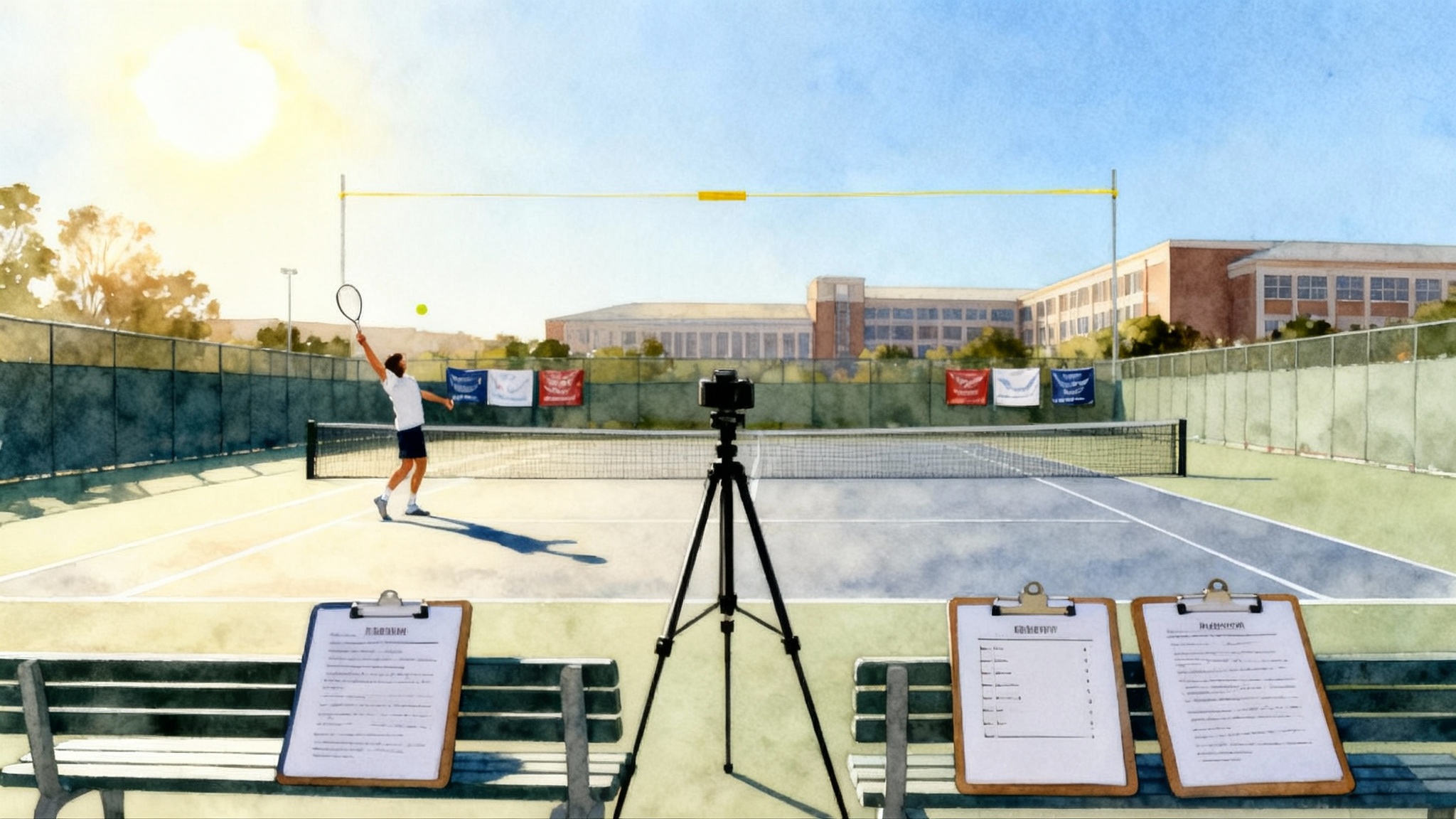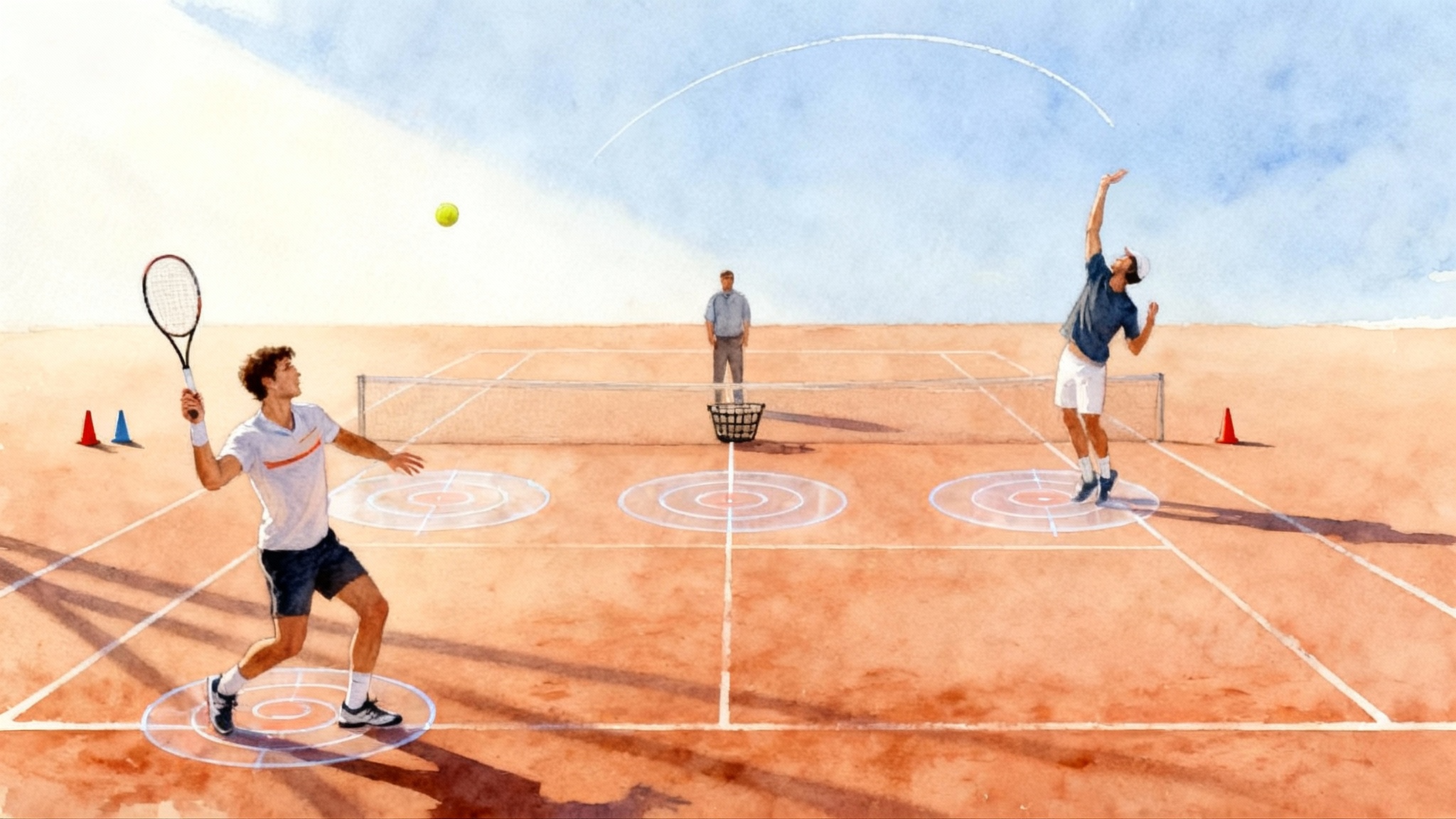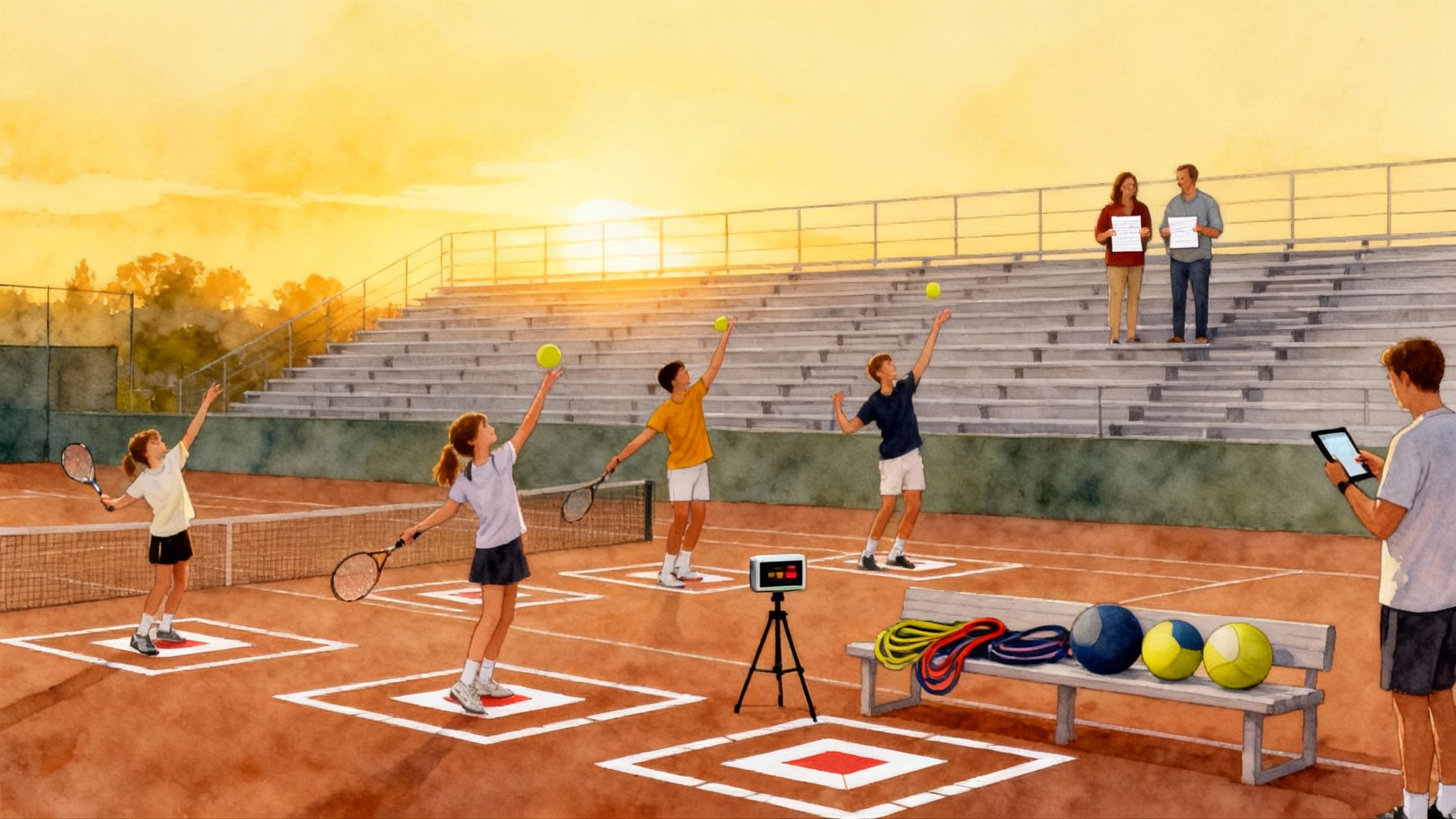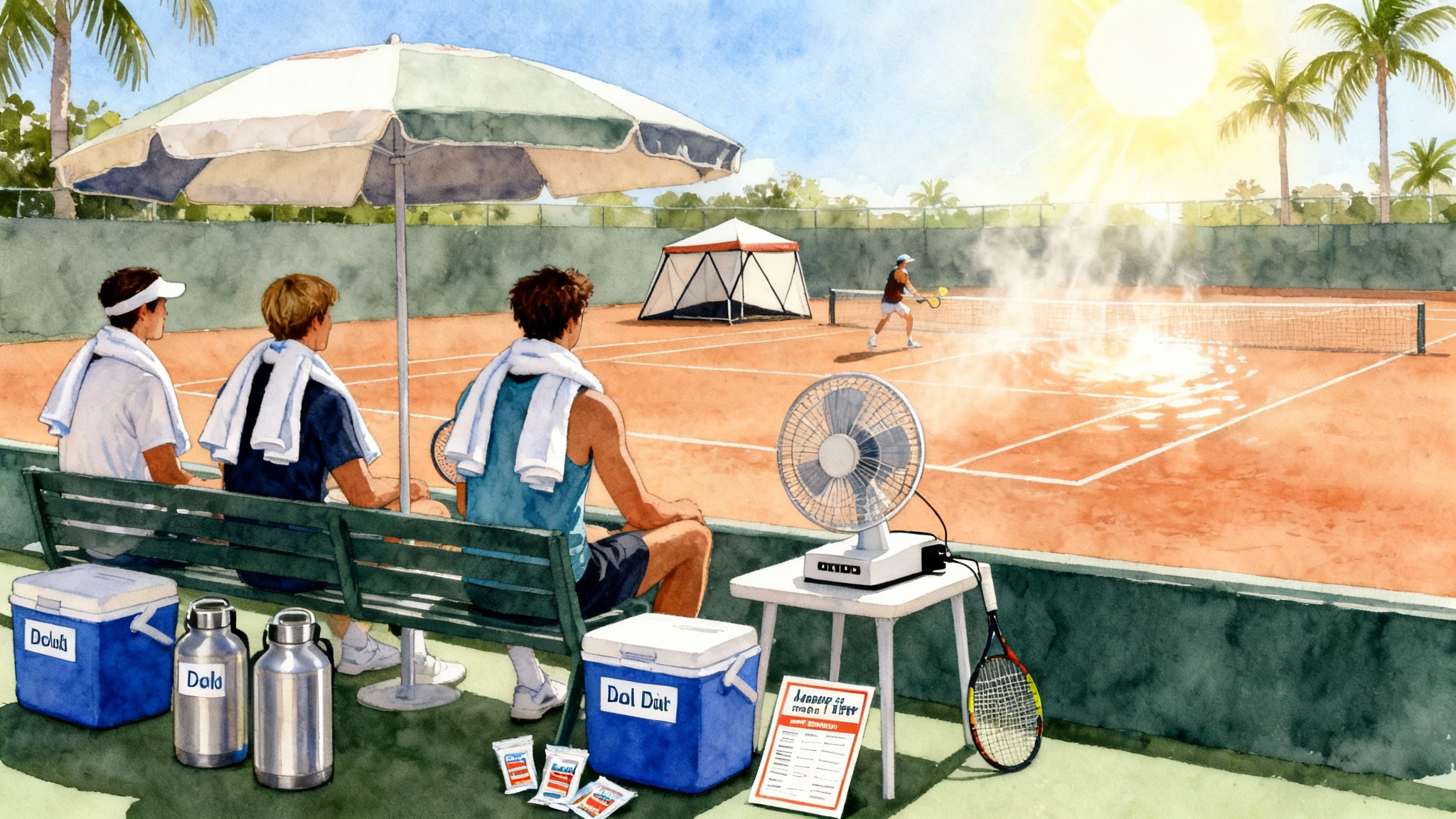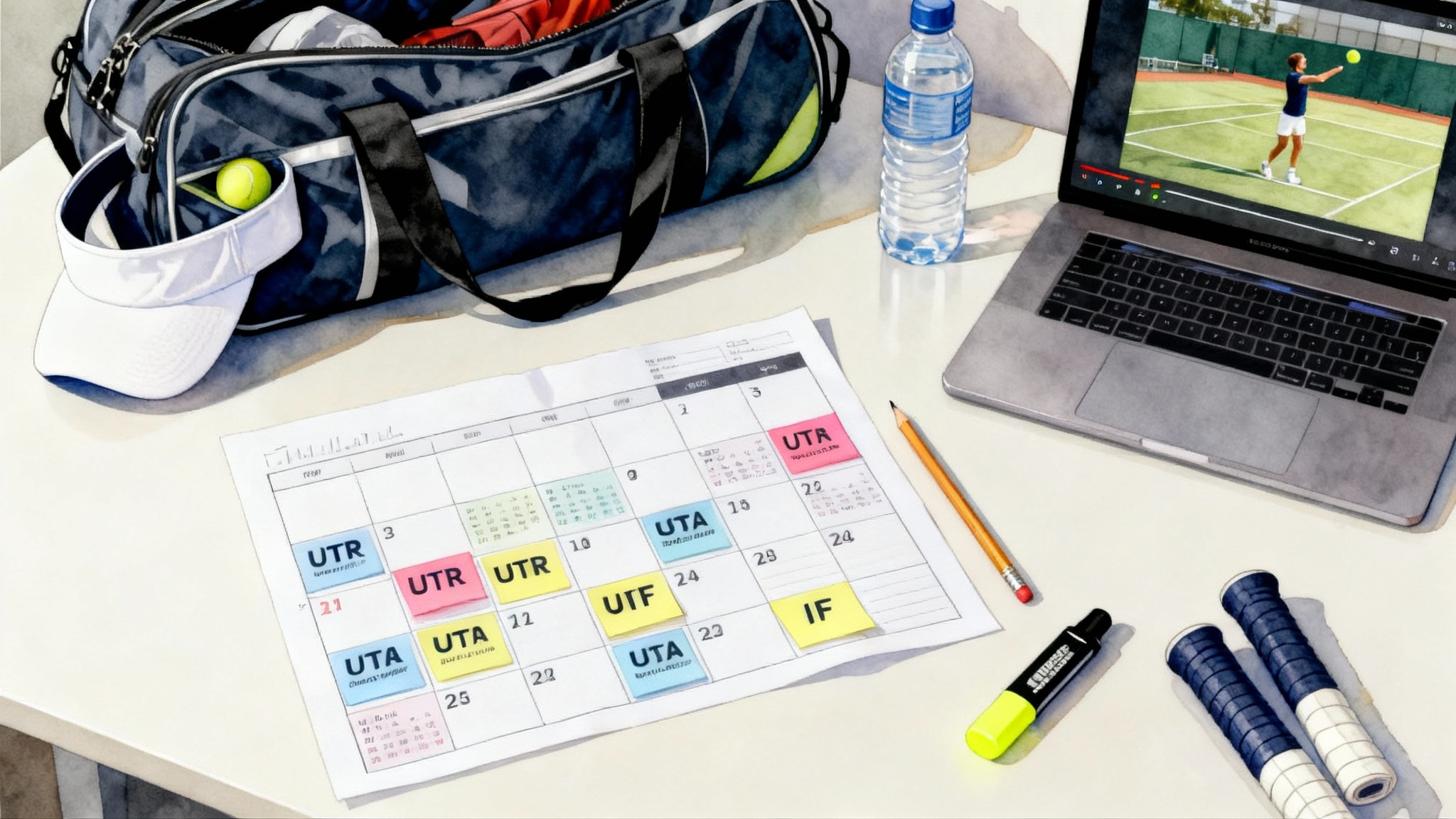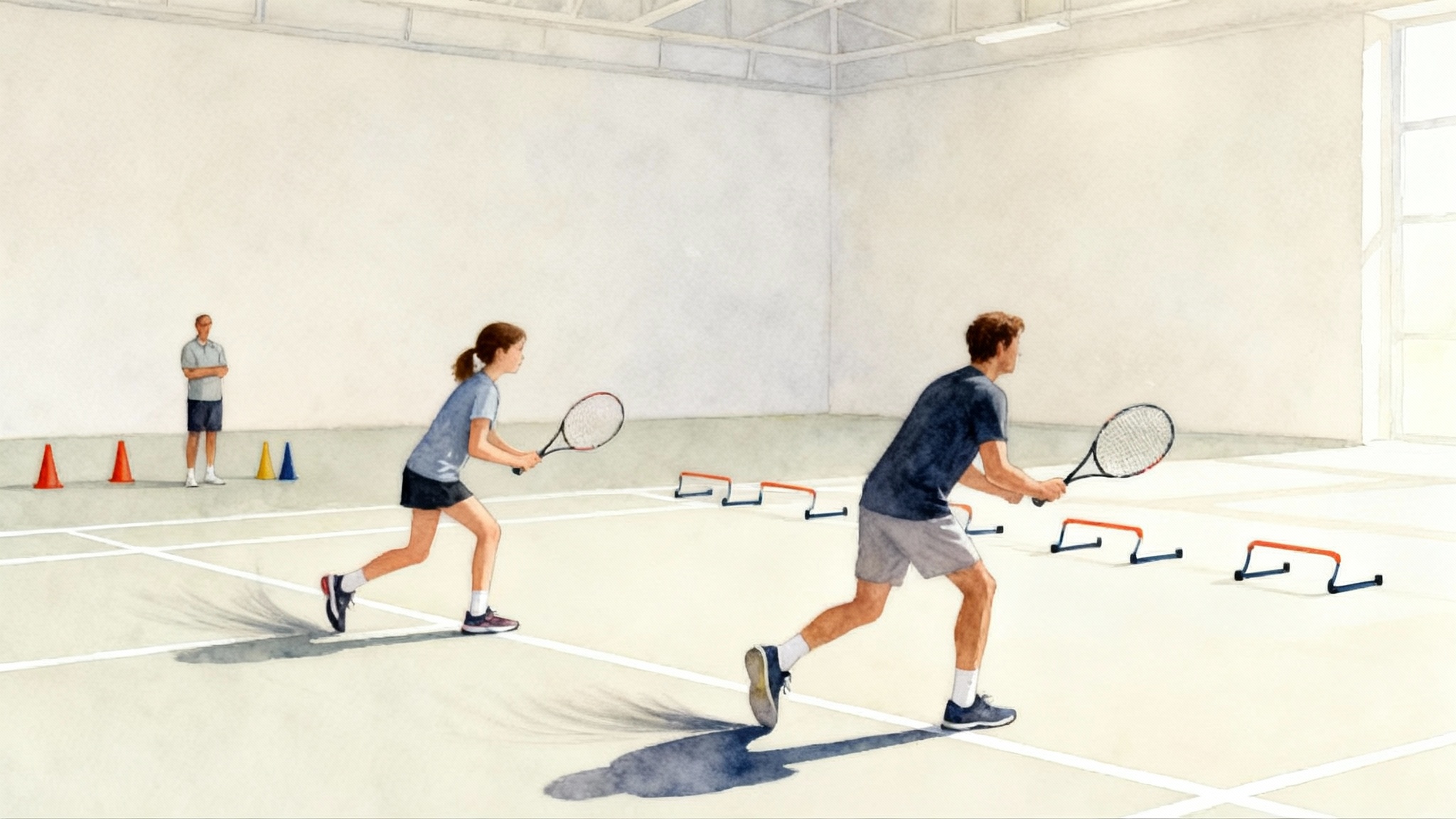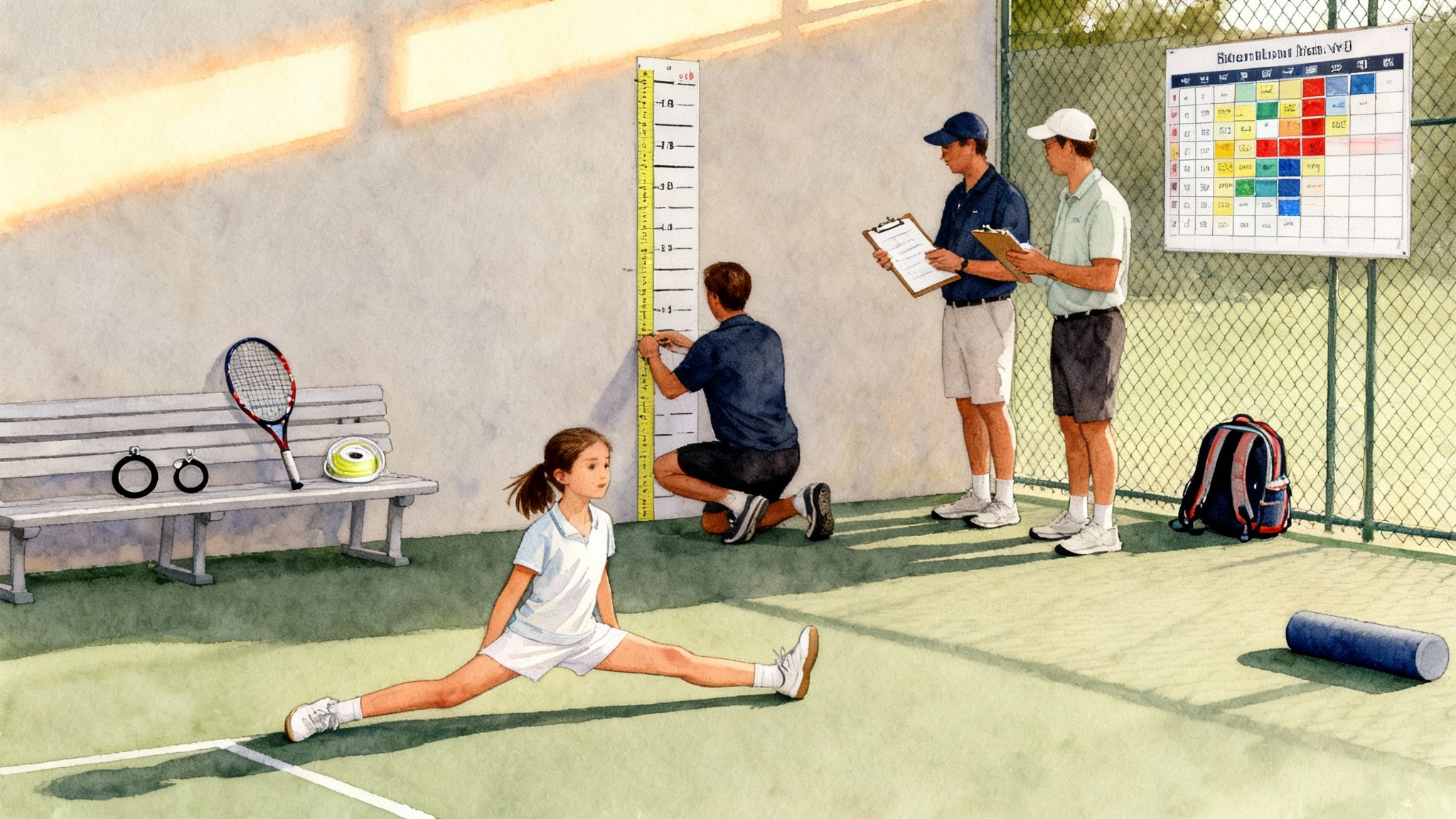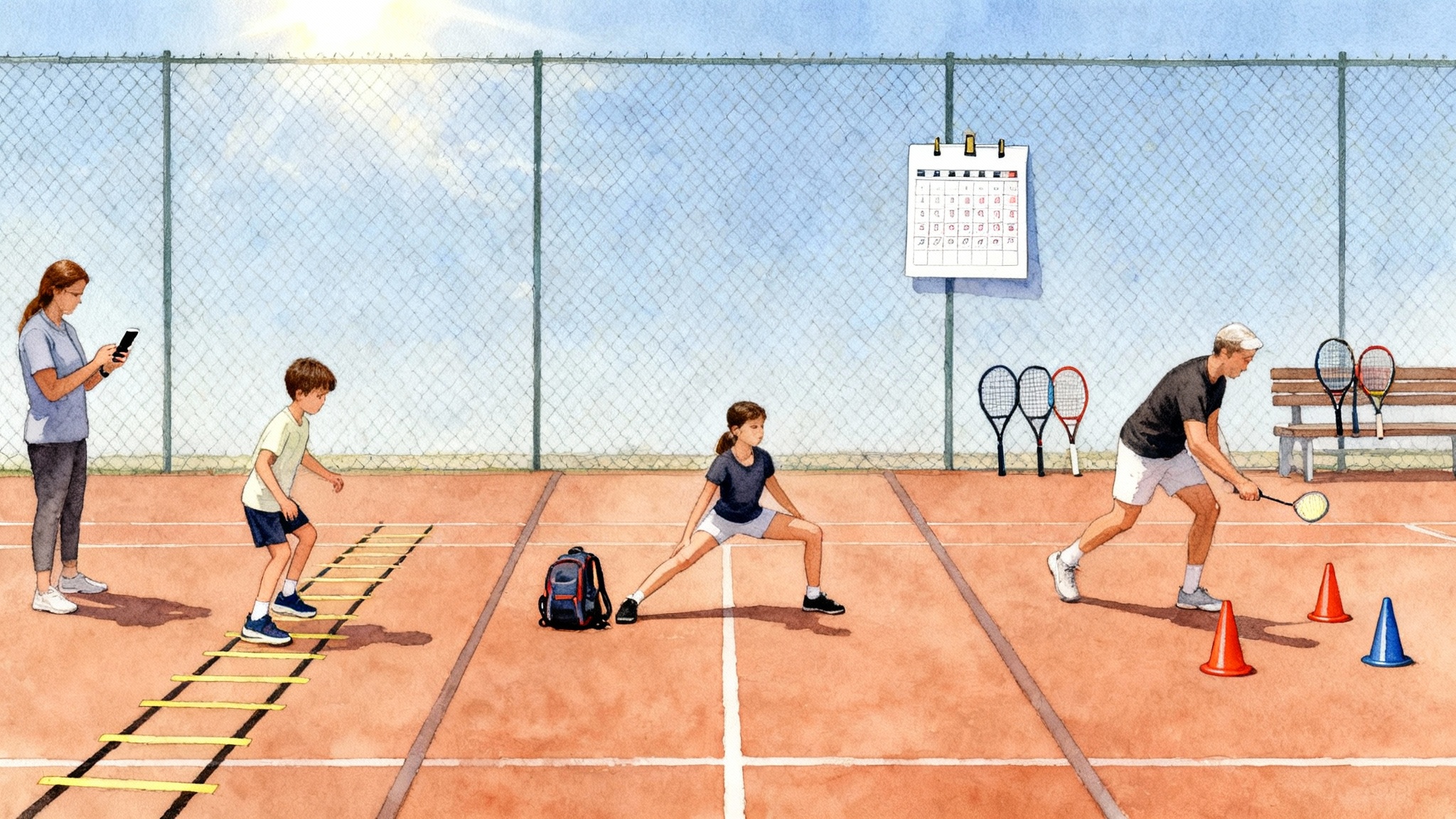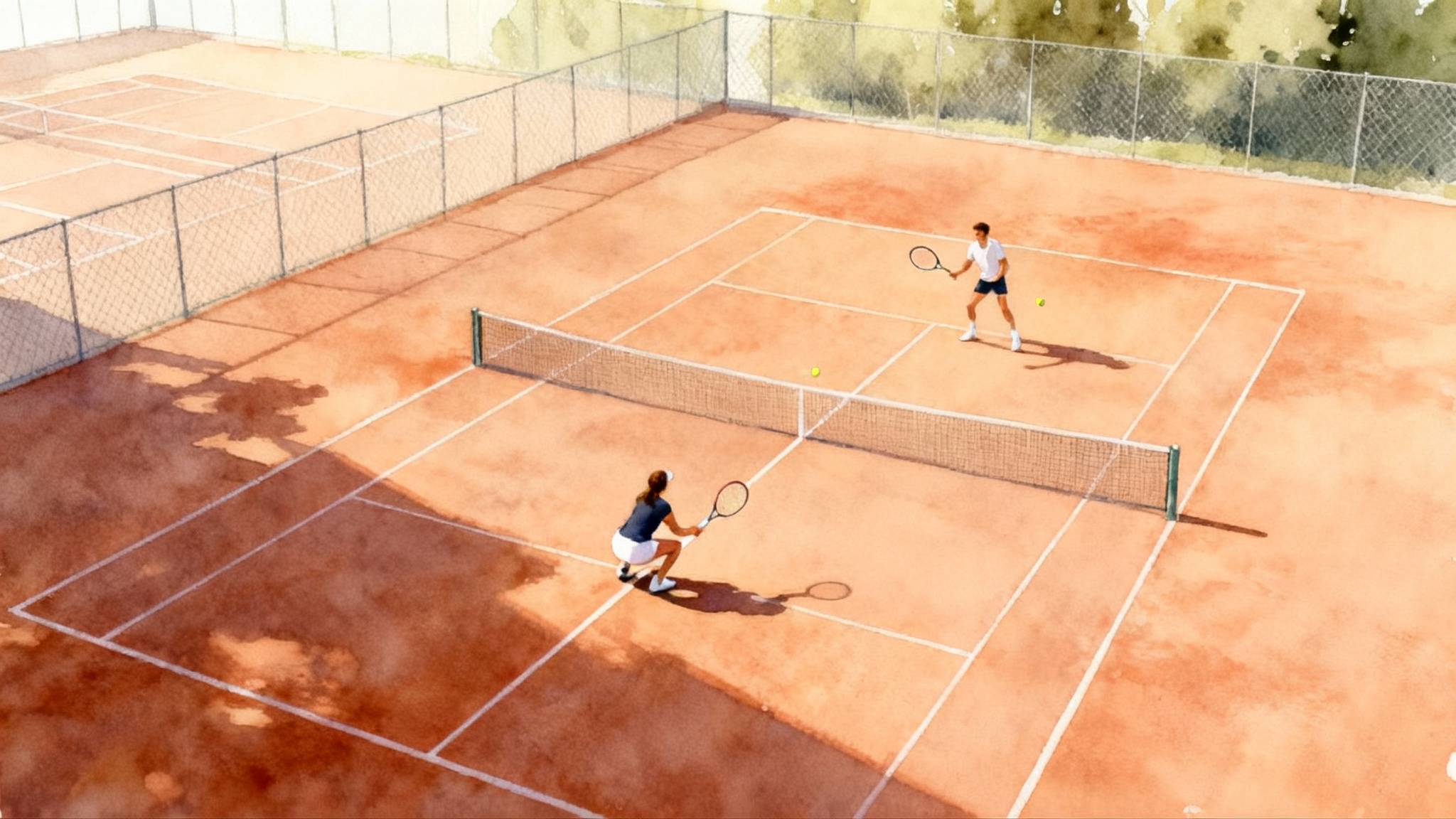Tennis Footwork Blueprint: Faster Feet in 30 Days Plan
Footwork wins rallies. Use this 30 day plan to build faster starts, cleaner stops, and smarter recovery on every surface. Clear drills, weekly schedules, and simple tests help players at any level move like pros.
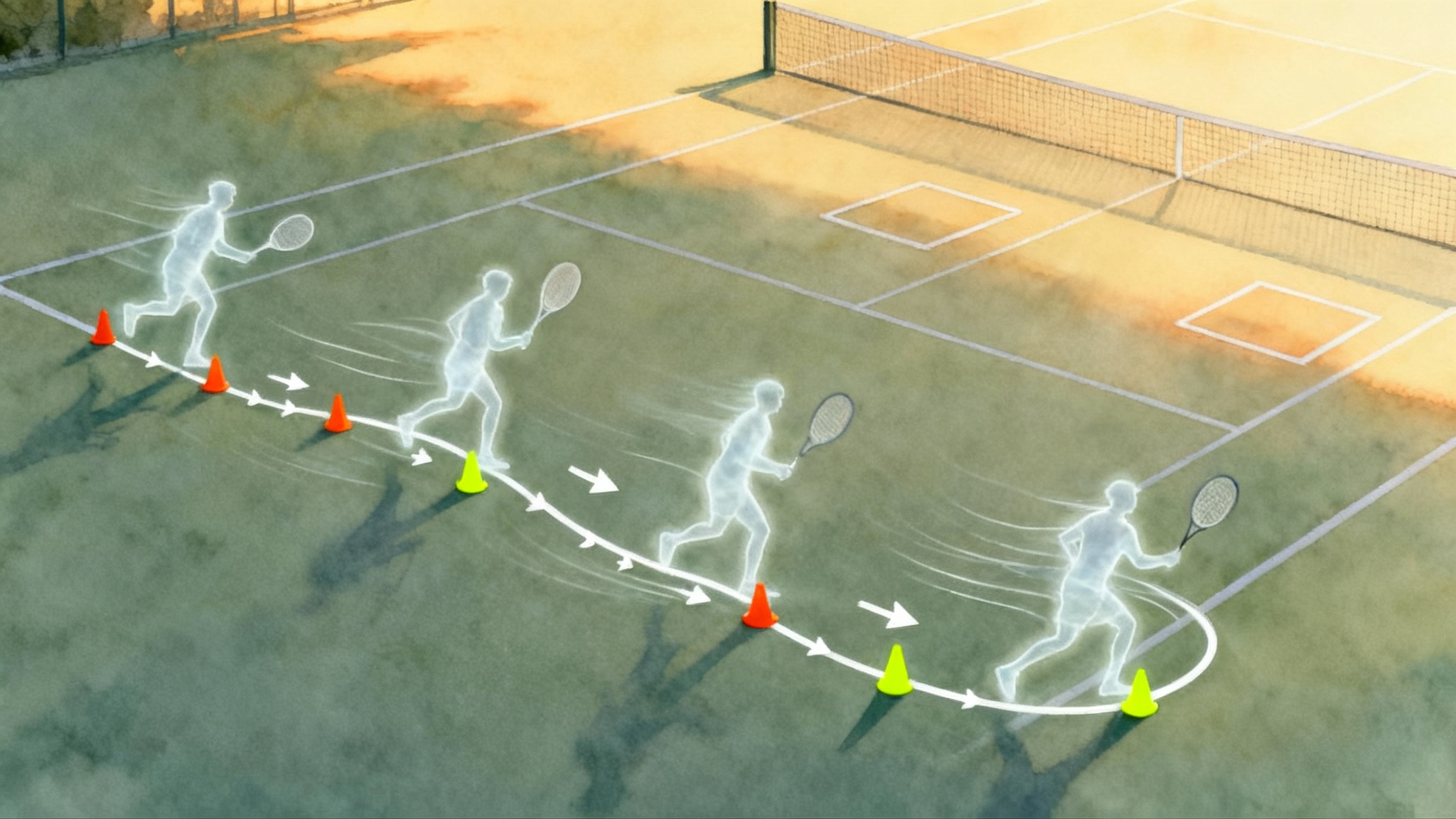
Why movement decides more points than strokes
If you watch a rally closely, you will notice a silent pattern that repeats from first ball to last ball: start, move, hit, recover. Players who handle that sequence better create time for themselves and take time away from opponents. Better movement turns average contact into solid contact and turns defense into neutral. This article gives you a practical, measurable plan to improve footwork in 30 days with proven tennis footwork drills. You will learn the key movement phases, the drills that matter, how to schedule short sessions you will actually complete, and how to track gains.
Think of tennis movement like a camera with four modes. Start is the moment the opponent hits. Move is the path you take to the ball. Hit is the contact move that matches the ball height and speed. Recover is the fastest route to the next shot. Master the modes, then string them together until they feel like one clip.
The four pillars of tennis movement
Pillar 1: Start
The start sets the rhythm. The split step is a small hop timed so your feet land as your opponent strikes. Landing gives you ground contact and quick options. Without it, your first step is late and the rally feels rushed.
Drills
- Split step metronome: Stand on the service line. Ask a partner to toss a ball in their hand and say “hit” when the hand peaks. Time your split so you land as you hear “hit.” Do 3 sets of 20 reps. Solo version: drop a ball from shoulder height, attempt to land the split the instant the ball hits the ground.
- First step audit: After the split, push off the outside foot in the direction of the ball. Use your phone in slow motion to see whether your first movement is a clean push or a small shuffle in place. For better checks, review smart phone video analysis tips.
- Direction calls: A partner calls left, right, or back as they pretend to hit. Land your split on the call, then take a single explosive step in that direction and stick the landing. Reset quickly. 3 sets of 8 calls.
Coaching cues
- Land softly on the balls of your feet, knees unlocked.
- Keep your chest tall and your eyes level as you land. Think calm on top, springy on the bottom.
Pillar 2: Move
The move phase is about speed that you can control. Good players do not only sprint; they accelerate under control, decelerate before contact, and take the last two steps like a dancer approaching a mark.
Drills
- Drop step and crossover: From a ready position, practice a quarter turn of the outside hip to create space, then a crossover step to accelerate. Work both directions. 3 sets of 6 reps per side.
- Cone lanes: Place two cones five large steps apart. Sprint to cone one, decelerate to light feet two steps before the cone, pivot, then sprint to cone two. You are training brake timing, not just top speed. 5 trips equals one set. Do 3 sets. For deeper mechanics, read deceleration and change of direction skills.
- Gravity runs: Lean from the ankles until you must step to catch yourself, then run five quick steps and ease into a stop. The lean teaches clean acceleration that comes from the ground up, not a frantic upper body.
Coaching cues
- Lower your center of mass slightly as you approach the ball. This helps clean braking and sets up a balanced hit.
- Think “long to short.” Opening steps are bigger and faster; closing steps are shorter and lighter.
Pillar 3: Hit
Contact moves are the bridge between movement and stroke. You do not choose one stance for all balls. The ball tells you which stance fits.
Common contact moves
- Neutral stance: Step across with the front foot when you have time and the ball is lower. Great for line drives.
- Semi open stance: Hips rotated partly forward on medium pace balls. Useful for heavy crosscourt exchanges.
- Open stance: Hips and shoulders more square to the net when you are wide or rushed. Lets you use ground force to rotate and recover fast.
- Hop and stick on wide balls: A small hop into the shot with a firm plant, then a push back to recover.
- Off back foot emergency: A defensive move used when you are late. Aim higher and deeper, accept a slower ball, and buy time.
Drills
- Contact ladder: Feed yourself tosses or ask a partner to feed four patterns in a row. Pattern one neutral, pattern two semi open, pattern three open, pattern four emergency. Repeat on both sides. The goal is not power; the goal is clean feet into clean contact.
- Two step finish: After contact, freeze for a count of one to check balance, then take two organized steps in your recovery direction. This teaches you to finish stable and to exit on purpose.
Coaching cues
- Match stance to ball height and time available, not to habit.
- You should feel pressure through the inside edge of the outside foot as you rotate. If you fall backward, your stance was wrong or your brake was late.
Pillar 4: Recover
Recovery is a race to the next neutral. The fastest player is not the one who sprints the hardest; it is the one who stops on balance and leaves smart.
Drills
- Compass recoveries: Set four small cones around your baseline position at north, south, east, and west. Move to any cone, shadow a forehand or backhand, then recover diagonally toward center. Change directions quickly. 3 sets of 45 seconds.
- Split and leave: Partner feeds a wide ball, you hit with an open stance, then recover with a crossover and a final small split at your target zone. Think hit then leave. 2 sets of 10 balls per side.
Coaching cues
- Recover toward the opponent’s best reply angle, not the middle line painted on the court. If you pull them wide crosscourt, your recovery target slides toward the open space.
- Glide off the outside leg after contact. A lazy first step makes you late twice: late to leave, and late to arrive for the next ball.
The 30 day plan that actually fits real life
This plan uses micro sessions that last 12 to 20 minutes and bolt onto your hitting days. You will train three days per week for four weeks. Add the work at the start of practice when your feet are fresh, or on rest days as a short stand alone block. If you play matches on the weekend, run your days Tuesday, Thursday, and Sunday.
Equipment list
- 6 to 8 cones, or water bottles
- A phone with a stopwatch and slow motion
- A jump rope, optional
Warmup, every session
- 2 minutes jump rope or line hops
- 2 minutes dynamic mobility: ankle circles, leg swings, hip openers
- 2 minutes movement prep: 3 split steps and first steps to each side, then 2 controlled accelerations to the service line and back
Week 1: Start and brake
- Block A, split timing: 3 sets of 20 split steps with the drop cue
- Block B, cone lanes: 3 sets of 5 trips, focus on smooth deceleration
- Block C, two step finish: 2 sets of 6 balls per side, shadow swing or soft feed
Target feeling: You land your split as the cue happens, not after. You arrive at the cone fast but stop without a skid. Contact feels calmer because your last steps are shorter.
Week 2: Acceleration and stance selection
- Block A, drop step and crossover: 3 sets of 6 per side
- Block B, contact ladder: 4 patterns x 3 rounds on each wing
- Block C, split and leave: 2 sets of 10 balls per side
Target feeling: You cover the first two steps quicker and choose a stance that fits each ball, rather than using one stance by default.
Week 3: Recovery awareness and direction changes
- Block A, compass recoveries: 3 sets of 45 seconds
- Block B, direction calls: 3 sets of 8 calls
- Block C, two step finish into recovery: 2 sets of 6 balls per side, exaggerate the first recovery step
Target feeling: Your mind knows where to go before the ball leaves your strings. Your first recovery step is automatic.
Week 4: Rally integration and pressure
- Block A, live ball sets: 10 ball cooperative rally to one side, then 10 to the other, repeating the movement pattern you trained. 3 rounds.
- Block B, spider drill: Place five balls at the corners and center of the court. Sprint to each ball, touch it, and return to start. Time the full set. Perform twice with full rest.
- Block C, match play focus: In a short set or tiebreak, choose a single cue to track such as split timing or first recovery step and grade yourself after each point.
Target feeling: Movement habits show up in real rallies. Your heart rate rises, but your feet stay organized.
Tests and simple metrics you can trust
You improve what you measure. Use these low tech tests at day 1 and day 30.
- Split timing check: Record ten opponent hits from the return position. Count how many times your feet are on the ground as the ball leaves the strings. Goal is 8 out of 10 or better. If alone, use the ball drop cue instead.
- 5 10 5 shuttle: Place cones on the baseline at zero, five yards left, five yards right. Start at zero, sprint to one side, across to the other, then back to the start. Time with a phone. Repeat twice. Look for a two to three percent improvement.
- Spider drill: Time yourself touching the five points at the service line and net positions. Focus on entering and exiting each point under control, not on sliding wildly.
- Rally stability score: In a 20 ball cooperative rally, count how many contacts you hit on balance. Start from your current number and aim to add three to five balanced hits by day 30.
Write results in a simple note. Numbers are a mirror. When the numbers improve, confidence follows.
Common mistakes and how to fix them
- Late split step: If you land after the opponent hits, move your split earlier until it syncs with contact. Use audio cues at first.
- Big last steps: If you slam on the brakes at the ball, start your deceleration two steps earlier and make those steps smaller.
- One stance for every ball: If every forehand is open stance, practice neutral stance on easy feeds and semi open on medium pace balls so you own all three.
- Recovering to the middle stripe: If you finished wide crosscourt, recover closer to the open court. Imagine you are guarding angles, not guarding paint.
- Upper body rush: If shoulders spin early, you are stealing power from your legs. Cue yourself to load the outside leg, then unwind from the ground up.
Singles and doubles movement differences
Singles rewards depth and angle control, so recovery often slides toward the bisector of the opponent’s likely replies. Doubles rewards first step speed to the net and quick diagonals for poaches.
Singles focuses
- Longer recoveries from wide positions back toward a central lane
- More open stance defense that flows into quick exits
- Deeper, higher targets when late to extend rallies
Doubles focuses
- Split step timing at the net that matches the striker’s contact
- One strong crossover to close the middle and a balanced stop before the volley
- Short, sharp recoveries after poaches so you are not stranded
Training tweak: In doubles practices, insert 30 second poach rounds where the net player times a split on every opponent contact and takes a single explosive step to intercept, then resets.
Junior and adult modifications
Young players and adults need similar skills but may need different workloads.
For juniors
- Keep work bouts short, 20 to 30 seconds, with frequent breaks
- Emphasize balance on contact rather than maximum speed
- Use simple games like cone tag to build first step quickness without boredom
For adult players
- Add a gentle mobility block to protect ankles and hips
- Use a warmup that raises temperature before fast moves
- Pair footwork days with the in-season tennis strength plan to support legs and hips
- Respect soreness after deceleration work and add a light recovery session the next day with walking and easy shadow swings
Building a habit that sticks after day 30
Footwork improves fastest when it becomes an automatic part of every hit. Use these three anchors.
- One cue per session: Choose split timing, first step, or recovery target. Track only that cue. Simplicity beats complexity.
- Micro sets: Even on busy days, perform two blocks of 5 minutes. Attach them to something you already do, like your serve warmup.
- Monthly test: Keep the 5 10 5 and spider drill in your calendar. Retest on the first weekend each month and adjust your plan.
What better movement feels like
After a month of consistent work, you will notice that the court feels wider and the ball feels slower. You arrive a fraction earlier, which makes your last two steps lighter. Balanced contact turns into cleaner strokes without extra effort. Recovery becomes a habit you do not think about. Matches feel less like emergency management and more like pattern control.
The game rewards anticipation that is built on movement. When your start is on time, your move is organized, your hit fits the ball, and your recovery aims at the next danger, you control the film of the point. That is the real blueprint: not just fast feet, but feet that arrive early, stop softly, strike on balance, and leave with purpose. Give the plan 30 days and measure the difference. Then keep the habit. Your future rallies will thank you.
